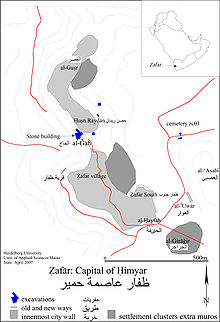ظفار | |
 | |
| Location | Ibb, Yemen |
|---|---|
| Coordinates | 14°12′41″N 44°24′31″E / 14.21139°N 44.40861°E |
| Type | settlement |
| Length | 1200 m |
| Width | 1000 m |
| Area | 110 ha |
| Height | 2800 m |
| History | |
| Builder | Himyarite |
| Material | stone |
| Founded | 2nd? century BCE |
| Abandoned | 6th century CE |
| Periods | Himyarite |
| Cultures | South Arabia |
| Site notes | |
| Excavation dates | 1998–2009 |
| Archaeologists | Paul Yule |
| Condition | badly plundered |
| Ownership | public |
| Management | GOAM |
| Public access | presently inaccessible |
Ẓafār (Arabic: ظفار), also Romanized Dhafar or Dhofar, is an ancient Himyarite site situated in Yemen, some 130 km south-south-east of today's capital, Sana'a, and c. 10 kilometres (6.2 mi) south-east of Yarim. Given mention in several ancient texts, there is little doubt about the pronunciation of the name.[1] Despite the opinion of local patriots in Oman, this site in Yemen is far older than its namesake there.[2] It lies in the Yemeni highlands at some 2800 m. Zafar was the capital of the Himyarites (110 BCE – 525 CE), which at its peak ruled most of the Arabian Peninsula.[3] For 250 years the tribal confederacy and allies' combined territory extended past Riyadh to the north and the Euphrates to the north-east.
- ^ Walter W. Müller, Encyclopedia of Islam 11 fasc. 185-186 (2001) 379-380 s.v. Zafar
- ^ G. Rex Smith, Ẓafār, Encyclopedia of Islam 11 fasc. 185-186 (2001) 380-381 s.v. Zafar
- ^ Paul Yule, Himyar-Spätantike im Jemen/Late Antique Yemen (Aichwald 2007) ISBN 978-3-929290-35-6
